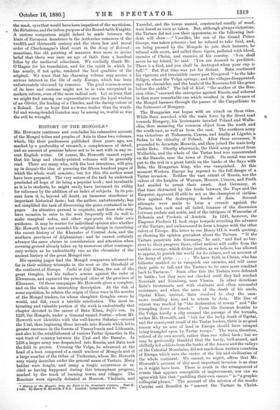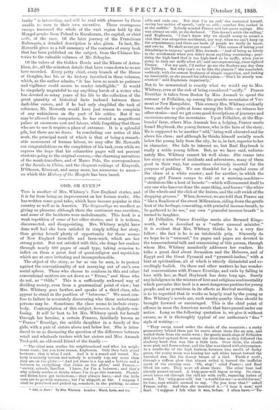HISTORY OF THE MONGOLS.*
Ma. HOWOBTH continues and concludes his exhaustive account of the Mongol tribes and peoples of Asia in these two volumes, which, like their predecessor published three years ago, are marked by a profundity of research, a completeness of detail, and an amount of genuine labour not to be met with in any re- cent English writer. Of course, Mr. Howorth cannot expect that his large and closely-printed volumes will be generally read. There are many who, with the best intentions, will give up in despair the idea of perusing the fifteen hundred pages of which the whole work consists ; but for this the author must have been prepared. The very nature of the task he undertook precluded all hope of its being a popular book ; and invaluable as it is to students, he might easily have increased its utility for reference by the addition of an index of subjects. In its pre- sent form it is, beyond all doubt, an immense storehouse of important historical facts ; but the author, unfortunately, has not simplified the task of discovering the gems contained in his pages. An attentive perusal is requisite, and those who may have occasion to refer to the work frequently will do well to make marginal notes, and other sign-posts for their own guidance. It may be matter for individual opinion also whether Mr. Howorth has not exceeded his original design in describing the recent history of the Khanates of Central Asia, and the northern provinces of Afghanistan ; and he cannot certainly advance the same claims to consideration and attention when covering ground already taken up by numerous other contempo- rary writers as he undoubtedly can as the chronicler of the ancient history of the great Mongol race.
His opening pages find the Mongol conquerors advanced as far in their military triumphs in the west as the threshold of the continent of Europe. Juchi or Juji Khan, the son of the great Genghis, led his father's armies against the ruler of Khwaresm, and captured the principal cities of the province of Khorasan. Of those campaigns Mr. Howorth gives a complete, and on the whole an interesting description. At the risk of some repetition, he relates the origin of these wars in the murder of the Mongol traders, for whose slaughter Genghis swore he would, and did, exact a terrible retribution. The most in- teresting and valuable portion of the work is undoubtedly that chapter devoted to the career of Bata Khan, Juji's son. In 1229, the Mongols, under a General named Suntai—whom Mr. Howorth now identifies with the well-known Subutai—crossed the Ural, thus beginning those inroads into Russia which led to greater successes in the forests of Transylvania and Lithuania, and also to the establishment of various Tartar dynasties in the vast tract of country between the Ural and the Danube. In 1238 a larger army was despatched into Russia, and Batu took the field in person. Crossing the Volga, he advanced at the head of a host composed of a small nucleus of Mongols and of a large number of the tribes of Turkestan, whom Mr. Howorth very wisely describes under the general name of Tartars. Many battles were fought, and many a tragic occurrence is re- cited as having happened during this triumphant progress, marked by the track of burning towns and villages. The Russians were signally defeated at Moscow, Vladimir, and • History of the Mongols. from the Ninth to the Nineteenth Century. Part II. 2 you". By Henry H. Howorth, F.S.A. London ; Longman' and Co. 1889.
Yaroslaf, and the towns named, constructed mostly of wood, were burnt as soon as taken. But, although always victorious, the Tartars did not cow their opponents, as the following inci-
dent will show Vassilko, the son of the Grand Prince George, was taken prisoner ; but he refused to take food, and, on being pressed by the Mongols to join their banners, he refused with scorn, and called them tigers, polluted with blood, enemies of Christ, and enemies of his country. You shall never be my friend,' he said. You are doomed to perdition. There is a God, and you shall be destroyed when your cup is full.' " But tlat time was yet far distant. Batu continued his vigorous and irresistible career past Novgorod "to the lake Seliger, where the Volga springs ; and the villages disappeared, says the chronicler, and the het:Ala:of the Russians fell like grass before the sickle." The fall of Kief, "the mother of the Rus- sian cities," crowned the enterprise against Russia, and ushered in that more remarkable one which resulted in the advance of the Mongol banners through the passes of the Carpathians to the fortresses of Hungary.
The Hungarian war began with an attack on three sides. While Batu marched with the main force by the direct road towards Hungary, his lieutenants invaded Poland and Walla- chia, thus menacing the common object from the north and the south-east, as well as from the east. The northern army was victorious at Todomeria, Czarna, and finally at Lignitz, a Sedan to the chivalry of Poland. After these successes, it proceeded to devastate Moravia, and then joined the main body under Batu. Shortly afterwards, the third army arrived from Wallachia, and the whole of the Tartar host was concentrated on the Danube, near the town of Pesth. Its metal was soon put to the test in a great battle on the banks of the Sayo with Bela, the Hungarian king, who was vanquished. At this moment Western Europe lay exposed to the full danger of a Tartar invasion. Neither the vast extent of Russia, nor the valour of the knights of Warsaw, Moscow, Cracow, and Pesth had availed to arrest their onset. And Germany, at that time distracted by the feuds between the Pope and the Emperor, appeared ill able to act as the champion of civilisa-
tion against the destroying hordes of Asia. Several attempts were made to form a crusade against the Tartars, but each and all failed, because of the dissension between prelate and noble, and of the intrigues of Wencealas of Bohemia and Frederic of Austria. In 1241, however, the Emperor Frederic II. took steps towards arresting the advance of the Tartars, and endeavoured to form a league with the other rulers of Europe. His letter to our Henry III. is worth quoting, as showing the opinion prevalent about the Tartars. " If the Tartars penetrate into Germany," he said, "and find no bar- riers to their progress there, other nations will suffer from the terrible scourge, which divine justice, as we believe, has allowed to appear, to punish the world for its crimes, and on account of
the decay of piety We have faith in Christ, who has hitherto enabled us to vanquish our enemies, and will cause their pride to fall, and the Tartars to be once more remitted back to Tartarus." Soon after this the Tartars were defeated in battle ; but they were not checked until they had reached Neustadt and Niunburg, near Vienna. In other directions Bata's lieutenants met with obstinate and often successful resistance, and when the news of the death of his uncle, Ogotai Khan, arrived, Batu resolved to obey the sum- mons recalling him, and to return to Asia. His line of retreat was marked by "the destruction of towns" and "the trampling down of forests." From the German frontier to the Volga hardly a city escaped the passage of the tornado, writes Mr. Howorth, and " but for the lucky death of Ogotai, and the consequent recall of the Tartar leaders, there is no good reason why an acre of land in Europe should have escaped being trampled upon by Tartar troops." The wave, therefore, retired of its own accord, rather than was rolled back ; but we may be profoundly thankful that the hardy, well-armed, and skilfully led soldiers from the banks of the Amour and the valleys of the Celestial Mountains, did not reach those western countries of Europe which were the centre of the life and civilisation of the whole continent. We cannot, we regret, affirm that Mr. Howorth's account of this most important invasion is as clear as it might have been. There is much in the arrangement of events that appears susceptible of improvement, nor can we agree with him that " paddling their own canoes " is "a graphic colloquial phrase." The account of the mission of the monks Carpini and Benedict to "convert the Tartars to Christ- ianity " is interesting, and will be read with pleasure by those unable to turn to their owu narrative. These courageous envoys traversed the whole of the vast region held by the Mongol armies from Poland to Karakoram, the capital, or chief ordu, of the race. Of the later journey of the Franciscan Rubruquis, a detailed description is also given. In fact, Mr. Howorth gives us a full summary of the contents of every book that has been published on the subject, from the Chinese his- tories to the valuable volumes of Mr. Schuyler.
Of the rulers of the Golden Horde and the Khans of Astra- khan, Sze., all the minutest details that have come down to us are here recorded. Every petty chief, every branch of the House of Genghis, has his or its history inscribed in these volumes, which, as the author admits, "it has been as much as patience and vigilance could secure to render intelligible." It would be singularly ungrateful to say anything harsh of a writer who has devoted so many years of his life to the collection of the great quantity of historical facts inclosed between these dark-blue covers, and if he had only simplified the task of reference, Mr. Howorth would have just reason to complain of any unkindness on the part of his critics. But if we may be allowed the comparison, he has erected a magnificent palace at enormous cost and labour, while forgetting that those who are to use it require a place of entrance. It is a splendid pile, but there are no doors. In concluding our notice of this work, the principal merit of which is that of being a remark- able monument of human labour, we may offer Mr. Howorth our congratulations on the completion of his task, even while we express the hope that his exhaustive pages will not prevent students going to the original sources,—the charming narratives of the monk-travellers, and of Marco Polo, the correspondence of the Jesuits in China, and the eloquent writings of Klaproth, D'Ohsson, Remusat, and many more, too numerous to name— on which this History of the Mongols has been based.



































 Previous page
Previous page